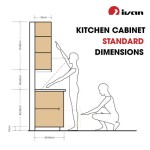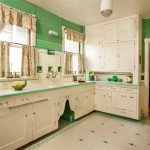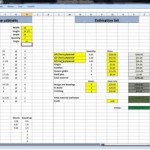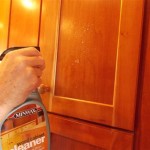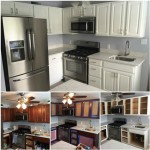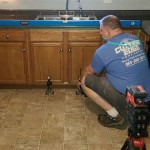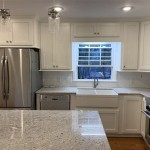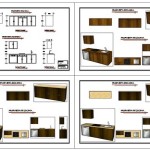What Colour Goes With Duck Egg Kitchen?
Duck egg, a serene and versatile hue, has become increasingly popular in kitchen design. Its subtle blend of green and blue undertones evokes a calming and sophisticated atmosphere, making it an excellent choice for cabinetry, walls, and accessories. However, effectively incorporating duck egg into a kitchen requires careful consideration of complementary colors to create a harmonious and visually appealing space. This article explores a range of color palettes that pair beautifully with duck egg, providing guidance for achieving various aesthetic styles within the kitchen.
Understanding the Undertones of Duck Egg
Before selecting complementary colors, it is crucial to understand the undertones within the specific shade of duck egg you are using. While generally considered a balanced blend, variations in duck egg paint can lean more towards green or blue. Observing these subtle nuances under different lighting conditions is essential. Natural daylight, warm incandescent light, and cool LED light can all alter the perceived color. Holding paint swatches against existing kitchen elements, such as countertops and flooring, will help determine whether a warmer or cooler palette would best complement the duck egg shade you have chosen. For instance, a duck egg with stronger green undertones might benefit from warmer accents, while a bluer duck egg might work well with cooler, more muted tones.
Consider also the level of saturation in your duck egg paint. Some duck egg shades are more muted and chalky, while others have a higher pigment concentration. A more saturated duck egg will hold its own against bolder colors, whereas a muted shade might require more subtle pairings to avoid being overwhelmed. This understanding will inform the selection of appropriate accent colors and ensure a balanced and cohesive design.
Classic and Timeless Combinations
For a classic and timeless kitchen aesthetic, consider pairing duck egg with neutral colors. These combinations create a sense of calm and elegance, allowing the duck egg to remain the focal point while providing a sophisticated backdrop.
White: Crisp white is a universally flattering complement to duck egg. It brightens the space and enhances the clean, airy feel often associated with this color. White can be used for walls, trim, countertops, and backsplashes. The contrast between the soft duck egg and the bright white creates a visual appeal that is both refreshing and timeless. Different shades of white can be used to create subtle variations in the overall look. For example, an off-white with warm undertones will soften the contrast, while a cool, bright white will create a more modern and dramatic effect.
Cream: Cream offers a softer alternative to white, providing a warmer and more inviting atmosphere. When paired with duck egg, cream creates a sense of understated elegance. This combination is particularly well-suited for traditional or farmhouse-style kitchens. Cream can be incorporated through cabinetry hardware, countertop materials like marble or quartz with cream veining, or through textiles such as window treatments and seat cushions.
Gray: Light gray, especially shades with warm undertones, can create a sophisticated and calming palette when used with duck egg. Gray provides a grounding element and prevents the duck egg from appearing too saccharine or overtly feminine. Opt for lighter grays to maintain a bright and airy feel. Darker grays can be used as accent colors, such as on a kitchen island or in open shelving, to add depth and visual interest.
Wood Tones: Natural wood tones, particularly light to medium shades like oak or birch, introduce warmth and texture to a duck egg kitchen. Wood can be incorporated through flooring, countertops, open shelving, and furniture. The organic nature of wood complements the natural feel of duck egg, creating a welcoming and harmonious space. Consider the grain and texture of the wood, as these elements will contribute to the overall aesthetic. Smooth, light-colored woods create a modern look, while more rustic, textured woods lend a farmhouse or traditional feel.
Modern and Contemporary Palettes
For a more modern and contemporary kitchen, consider bolder and more unexpected color combinations. These palettes often rely on contrast and unexpected pairings to create a visually striking and impactful space.
Charcoal Gray/Black: Pairing duck egg with charcoal gray or black creates a dramatic and sophisticated contrast. This combination works particularly well in kitchens with ample natural light. Black can be used for accent walls, islands, or lower cabinetry, while duck egg can be used for upper cabinets and walls to maintain lightness. Consider incorporating metallic accents, such as brushed brass or copper hardware, to add warmth and visual interest to this bold palette.
Copper/Brass: Metallic accents, particularly copper and brass, provide a warm and luxurious contrast to the cool tones of duck egg. These metals can be incorporated through hardware, lighting fixtures, and accessories. Copper adds a rustic, industrial touch, while brass offers a more glamorous and sophisticated feel. The warm shimmer of these metals complements the muted tones of duck egg, creating a visually appealing and balanced space.
Terracotta/Rust: For a more earthy and contemporary feel, consider pairing duck egg with terracotta or rust tones. These warm, earthy colors provide a strong contrast to the cool tones of duck egg, creating a dynamic and visually interesting palette. Terracotta can be incorporated through flooring, backsplashes, or accessories. Rust tones can be used for accent walls, textiles, or smaller decorative items. This combination creates a sense of warmth and grounding, making the kitchen feel both inviting and stylish.
Navy Blue: A deep navy blue can create a striking contrast with duck egg, offering a sophisticated and elegant modern feel. Navy can be used for a kitchen island, lower cabinets, or an accent wall. The drama of the navy, paired with the subtlety of duck egg, creates a balanced aesthetic. Consider incorporating white or light-colored countertops to further brighten the space and enhance the contrast.
Harmonious and Natural Combinations
For a more harmonious and natural kitchen aesthetic, focus on colors that complement the inherent green and blue undertones of duck egg. These combinations create a calming and cohesive space that feels connected to nature.
Sage Green: Pairing duck egg with sage green creates a serene and harmonious palette. Sage green complements the green undertones of duck egg, creating a sense of tranquility and natural beauty. Sage can be used for walls, accent cabinets, or accessories. This combination works particularly well in kitchens that prioritize a calming and relaxing atmosphere. Consider incorporating natural textures, such as wood and stone, to further enhance the organic feel of the space.
Pale Blue: A soft, pale blue creates a calming and airy atmosphere when paired with duck egg. This combination is particularly well-suited for kitchens with ample natural light. Pale blue can be used for walls, backsplashes, or textiles. The subtle variation in tone creates a sense of depth and visual interest without overwhelming the space. Consider incorporating white or light-colored accents to further brighten the space and enhance the airy feel.
Beige/Taupe: Warm beige or taupe tones provide a grounding and neutral backdrop for duck egg. These colors complement the natural feel of duck egg, creating a sense of warmth and comfort. Beige or taupe can be used for flooring, walls, or countertops. This combination works particularly well in kitchens that prioritize a relaxed and inviting atmosphere. Consider incorporating natural materials, such as wood and linen, to further enhance the sense of warmth and texture.
Coral/Peach: Introducing a touch of coral or peach can inject warmth and vibrancy into a duck egg kitchen while maintaining a harmonious feel. These colors work best as accents, perhaps in textiles, artwork, or small appliances. The subtle pop of color complements the soothing tones of duck egg without overpowering the overall aesthetic, creating a balanced and inviting space.

What Colours Go With Duck Egg Blue The Guide Kitchen Style Colour Schemes

Style File Duck Egg Blue House Of Hawkes

What Colours Go With Duck Egg Blue The Guide Colour Palette

Kitchen In Duck Egg Blue Twenty Six

What Colours Go With Duck Egg Blue The Guide

What Colours Go With Duck Egg Blue The Guide Kitchen Aga Cooker Cabinets

Ideal Interiors The Magic Of Duck Egg Blue Homify

Incorporate Duck Egg Blue Into Your Kitchen Design Blog

Contemporary Duck Egg Kitchen

What Colours Go With Duck Egg Blue The Guide
Related Posts

